You just woke up at 3am to the sound of a loud thud, and no, it wasn’t the dog knocking a plant over. Your home is being invaded by a violent criminal and he’s done this before.
Unlikely scenario you say? Lets look at a few numbers… 1,030,000… that’s the average number of annual home invasions in the U.S.—home invasion is defined as a break in with someone home. 26%… the percentage of home invasions in which a resident becomes a victim of violent crime—that means 266,560 times per year, a victim is assaulted, stabbed, shot, raped, and/or murdered during a home invasion in the U.S.. 2,821… the number of home invasions every single day in the U.S.. 1 in 115 the odds that during a given year you will be home during a home invasion. Still seem so unlikely?
Returning to our scenario, you awoke to a bump in the night and your house is now one of the more than quarter million per year that will fall victim to a violent home invasion. You leap from your bed and must take immediate action. What are you grabbing? What do you keep by your bed in case of emergency? A bat? A knife? If you are aware of the harsh realities, and want to ensure that you always have the invader at a disadvantage, you hopefully grabbed a firearm. Here, we’re going to examine which firearm you might want that to be, and what you should take into consideration when selecting the best home defense weapon for you.
[Disclaimer: I know more than most gun owners about the realities of defensive weapon use, but I am not an expert. Take my advice with a grain of salt, and seek professional training and advice (not that of a guy behind the gun store counter).]There are three categories of firearm to consider for home defense. They are rifles, shotguns, and pistols. Each has its own pros and cons, and each has an ideal application, or POU (Philosophy of Use). A smart man said, “Long guns kill bad guys, pistols make them run away.” In a perfect world, if you have to use your home defense firearm, you would shoot the bad guy once with a pistol, he’d run away, and would be one of the 9 in 10 people shot with a pistol, who survive their injuries. Unfortunately we do not have the luxury of assuming that they will run away after the first hit, so I prefer the approach of delivering the most force possible, as quickly as possible, to ensure that the threat to you and your family stops NOW. Not in two minutes after they lose enough blood to make them pass out—because, oh by the way, they killed you and your family in those two minutes…
So we’ve established that pistols are hardly a guaranteed fight stopper. Then, what is? Rifles and shotguns. Rifles like the AR-15 are a good choice for home defense. They are relatively simple to operate, and contrary to what Uncle Biden would have us believe, they are much easier to handle than a shotgun. The recoil of an AR-15 will not have you shooting up at the bad guy from your ass and the 30 rounds in the magazine (assuming you don’t live in an oppressive police state) will give you plenty of bang to deal with even a few home invaders on PCP. So long as a whole gang isn’t invading your home, a single AR mag will be enough. The number one drawback to an AR-15 is the risk of massive over-penetration through walls. ALL home defense firearms will punch through a wall and kill the person in the next room, if you miss your intended target. The trouble with the 5.56mm/.223 that the AR shoots, is that you’re likely to kill your neighbors with any shots you miss. This is also a concern with handguns and shotguns, but to a lesser degree.
I feel it important to mention here that it is a myth that 5.56/.223 rounds fragment or tumble when they pass through walls. They don’t. Go watch some ballistic tests on YouTube. If you don’t know what I’m talking about, AR rounds generally fragment and/or tumble end over end when they enter soft tissue. It is rumored that these same characteristics cause them to expend most of their energy if they pass through anything. They don’t.
Another consideration with a rifle, which is even more true of shotguns, is size. If you have a cramped house or have to make an awkward turn when exiting your bedroom, you may simply not be able to wield a long gun effectively in your house. Remember that no amount of firepower is going to help you if you get shot trying to leave your bedroom.
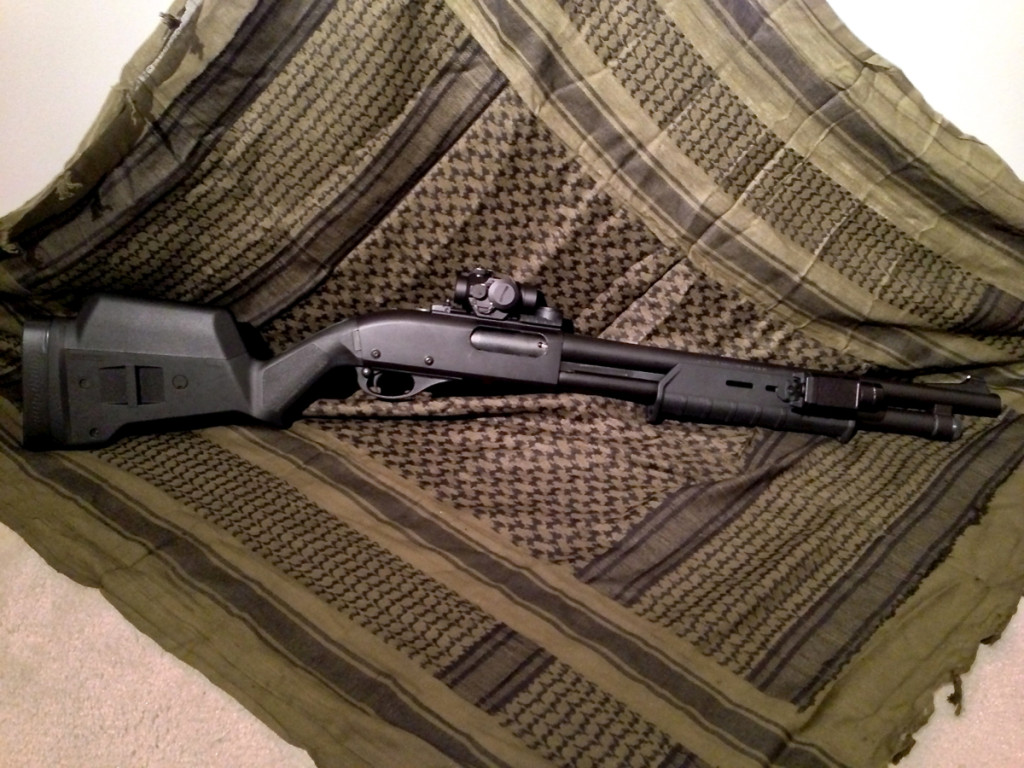
Bird shot. Dick Chaney shot a guy in the face with bird shot, and he was fine, save for some serious cosmetic issues. Bird shot is not a defense load, but rather a hunting load. In ballistic testing it proves to be a shotgun load that would cause a very nasty wound at close range, but penetration can be shallow enough that you have no guarantee that the bad guy will stop.
Shot spread. Movies, video games, and popular myths would have us believe that a shotgun scatters its shot into a broad wall of lead, guaranteeing you a hit even if you suck at aiming. In reality, even a shotgun barrel without a choke (the tube in the end of the barrel that narrows the shot spread) will only cause shot to spread at 1 inch of spread-diameter per yard traveled. That means that at the longest home defense distances, your shot spread is only about 6-8 inches wide. If you suck at aiming you’re still going to miss; given that fact, I recommend a choke tube to tighten your shot pattern.
Racking the shotgun. In the movies, when you rack the pump on a shotgun, the bad guys drop their guns, get on their knees, and plead for forgiveness. In real life you might scare off a 16 year old that thought he’d try his hand at burglary, but you’re not scaring off an experienced criminal. You rack the gun the second you feel there is any danger and you rack it to put a round in the chamber… not to scare someone off. Personally I’ve practiced racking my shotgun slowly and quietly because I’d rather not give away my location. I’d rather turn the element of surprise back on the intruder.
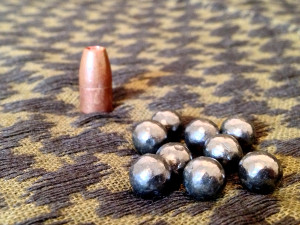
So in the plus column for the boom stick, we have lesser chance of over penetration and most violent effect on target. Add to that, the fact that long guns are inherently easier to aim quickly, and the shotgun certainly makes for a no-nonsense home defense gun, if you have the space and training to use it.
You might now be wondering what’s so damn tough about using a shotgun, so we’ll touch on that before talking about pistols for home defense. If you’re standing in a range stall shooting a target, a pump shotgun isn’t much more complex than a rifle. You need to run the pump hard, and get used to the ergonomics, but overall it’s fairly simple in a static situation. Add stress, reloading, and moving into the equation, and where an AR-15 will work with you, the shotgun will work against you. Reloading a shotgun in a hurry is something that can be tough without someone shooting at you. Getting it right under fire would prove nearly impossible for anyone without proper training. Another issue with a shotgun is jams. If you short-stroke the pump (don’t rack it fully), you can end up with one empty shell in the breach with the fresh shell stuck below it. This condition is hard to deal with even if the sun is shining and you’ve got time to break for lunch in between shots. If shotguns are starting to sound a bit intimidating, that’s good. If you’re not going to put the time into combat training and practice, you’re better off with a rifle. House too small for a rifle or a shotgun? Guess it’ll be a pistol then.
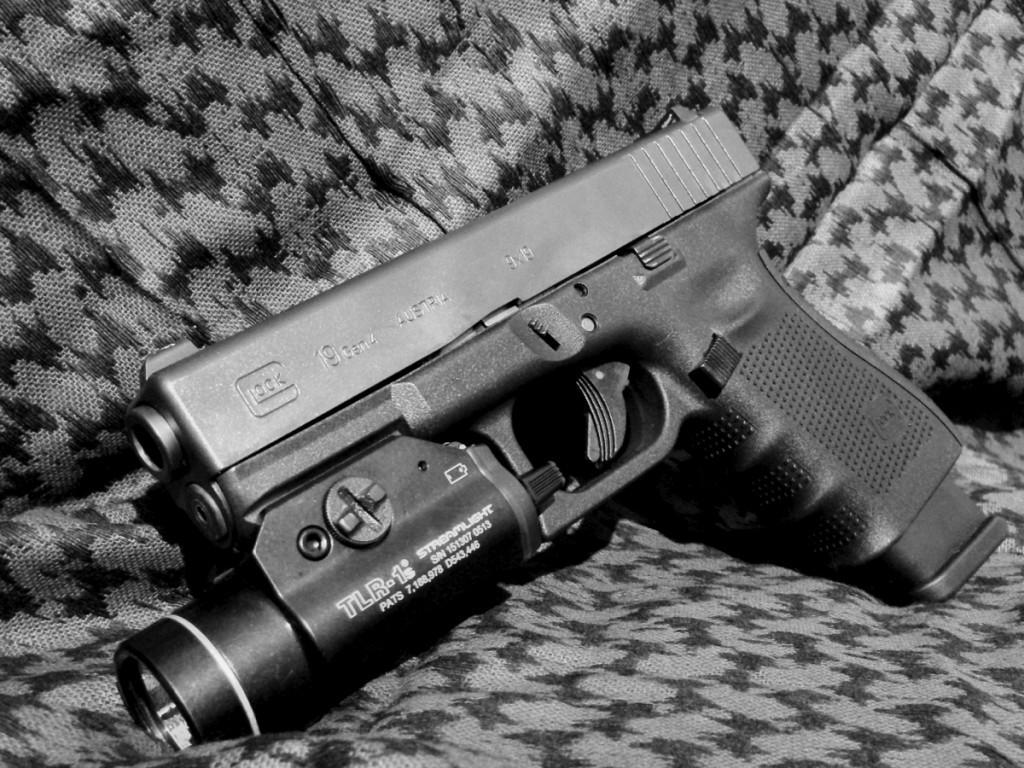
I have two home defense guns. A Remington 870 Tactical Magpul Edition and a Glock 19 Gen 4. The reason for two guns is that my house is too cramped to run the shotgun if I need to leave my bedroom. The shotgun is therefore for barricading in my room and waiting for either the bad guy to come up the stairs or for the police to show up and stop the situation (whichever comes first). The Glock is for if I need to go check out what’s happening. My bedroom door opens into a narrow hallway, and the door blocks my line of site to the front door until I can close it behind me. This leaves no room to maneuver with the shotgun.
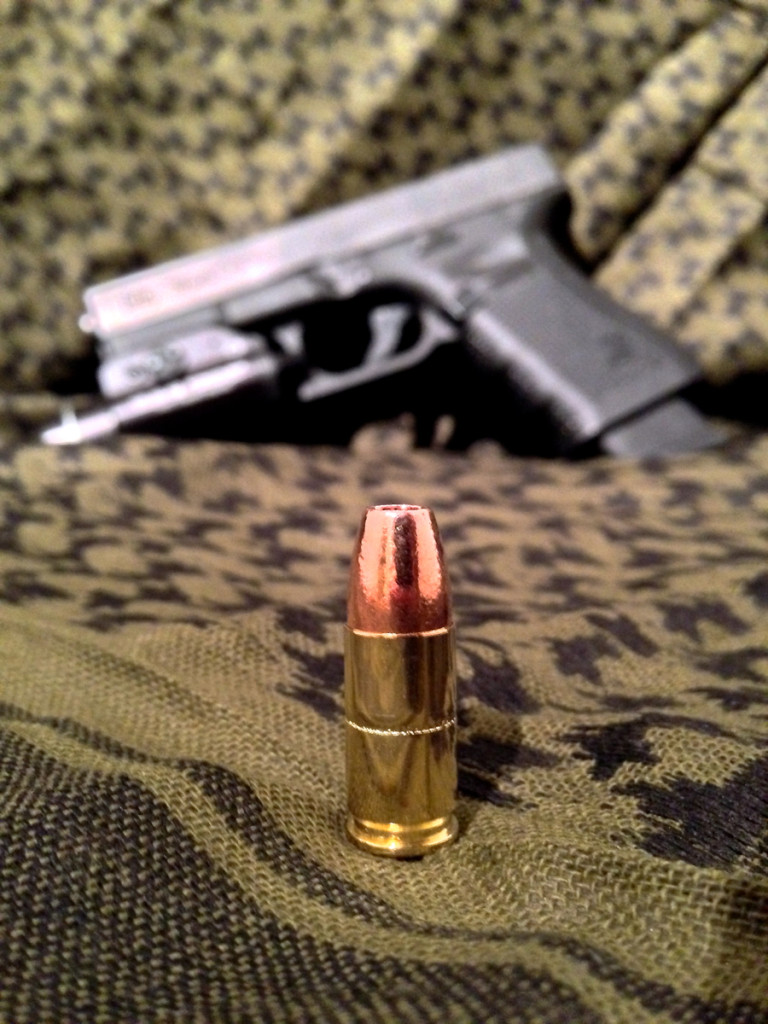
to protect the trigger. On it, I have replaced the stock sights with XS BigDot sights with tritium inserts (tritium inserts are radioactive and glow continuously and brightly). These sights make it very easy to get on a broad target quickly, and ensure visibility at night. At the front of the gun I also have a Streamlight TLR-1s
weapon light, which is an affordable LED weapon light that throws a 300 lumen flood on your target. I also leave a 17-round mag in the gun, loaded with Corbon DPX rounds, to maximize the chance of the Glock stopping the fight with some quick shooting. Note: I have stopped using Corbon DPX because the bullets become unseated from the case after being chambered a few times. I switched to ASYM SDX which uses the same bullet, loaded in a case that holds onto it.
If you’re wondering, a home defense pistol should remain hot at all times, with a round in the chamber. Under stress you don’t want to forget to rack the gun and end up with a click, when you needed a bang.
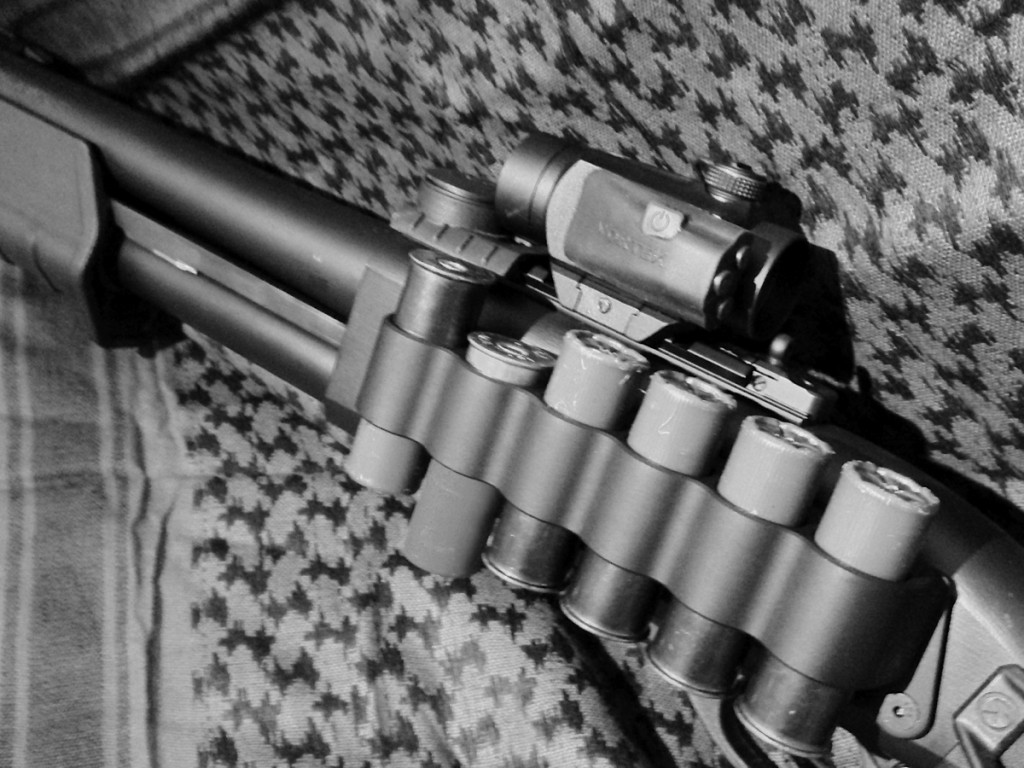
carrier. This is a quality, aluminum shell carrier which mounts to the right side of the gun by being pinned right into the receiver. In the carrier, I have 4 00 buck shells facing brass-down to make them easy to load into the magazine tube. There is then one 00 buck facing brass-up, to be used as an emergency reload straight into the chamber if I run the tube dry. I also keep a 1oz slug in the carrier, positioned to be breach-loaded. This is in case a shot ever needs to travel beyond 20 yards, and I frequently practice a drill that allows you to clear the chamber and load the slug in about a second. The reason for the the 20 yard figure is that beyond 20 yards, my Improved Cylinder choke tube still allows the shot to spread too wide. Past 20 yards, some of the shot would miss a human torso, necessitating a single projectile. If you, as the shooter are good enough, a Remington 870 with an 18.5″ barrel (the shortest shotgun barrel length you can own without doing a lot of paperwork) can hit a torso-sized target out to about 150 yards with total consistency.
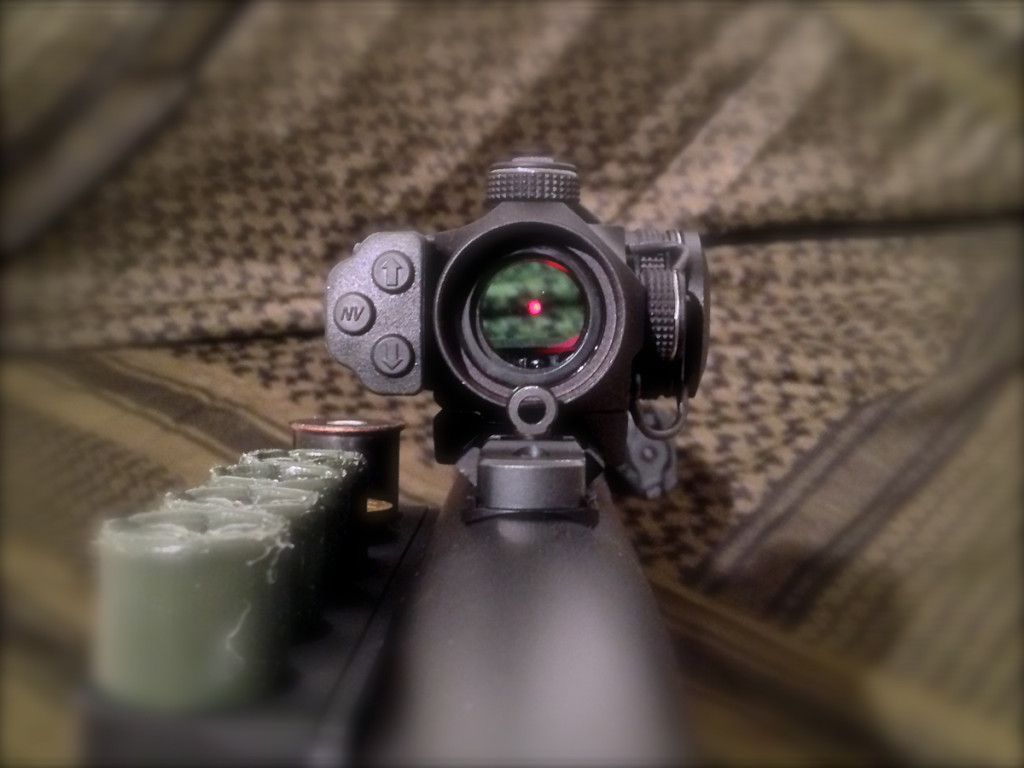
. It is a compact red dot which mounts to the rail on the 870 Tactical. Shock and water resistant, with all the major features of the $500+ competitors, the Vortex SPARC is only $200. Value for money is off the charts and I find a red dot the perfect optic for buckshot at 5-20 yards or slugs at 100. In the picture of the whole shotgun, above, you will also notice something affixed to the rail in front of the SPARC. That is a Vortex battery holder
which holds a spare battery for the SPARC.
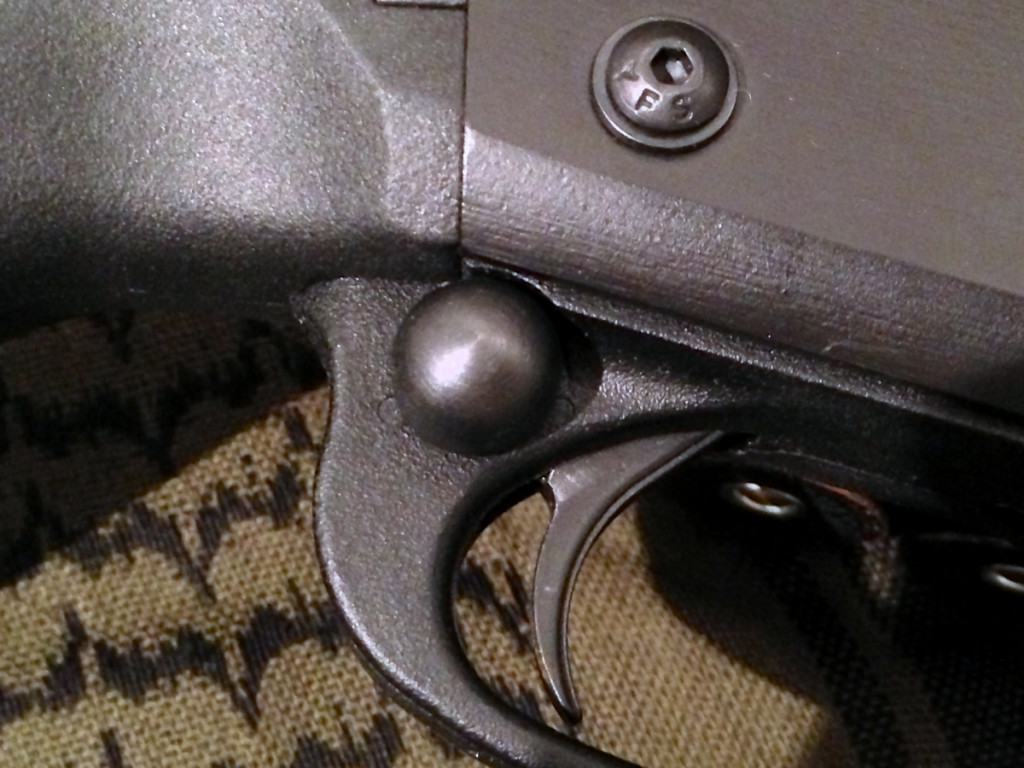
that I added to the pump. If you run this gun with the light, but without the red dot, the light illuminates the front sight from this position. This is best case scenario if you’re going to run the iron sights, and it means there is no need to glow sights on your shotgun. Behind the trigger, I swapped out the stock safety for a super sized dome safety. As a rule I don’t use the safety, but it comes in handy at the range when I use the safety for passing off to a guest shooter. If you prefer to use the safety on your home defense guns, I highly recommend this cheap upgrade, as the stock safety would be impossible to toggle off in a hurry if you forgot to switch it off until it was time to shoot. Personally I think safeties are just one more thing to get in the way when you need to use a gun in an emergency. Nowhere in the 4 rules of gun safety does it say “The safety must be on at all times.” Follow the 4 rules and you’ll be fine.
To sum it all up, there is no one perfect home defense weapon. My recommendation would be a shotgun if you have space to maneuver and time to train with it, a rifle if you have space but are lazy or lacking in IQ, and a pistol if you don’t have space to run a long gun. Make sure you pick the right rounds, be it shotgun or pistol. You need to stop the threat now, not later. Your pistol rounds should be modern rounds like the Corbon DPX, which have advanced design and ballistics. Your rifle should simply be loaded with 9-pellet, 2.75″ shell, 00 buckshot. Slugs over-penetrate and can cause less overall trauma at home defense ranges, compared to buckshot. Also remember that low recoil ammo is also low power. Physics are absolute and the only way to reduce recoil is to reduce muzzle energy (at least when speaking about the round itself).
The most important thing to remember is that you can never miss or fumble fast enough. If you aren’t going to put in the time and dollars to learn a gun, buy one that you will train with. If you aren’t going to train at all, you have no business using a gun for home defense. You’ll just get yourself or a family member killed when you try to perform under stress.
Check out some of the supporting products that make up my home defense setup.

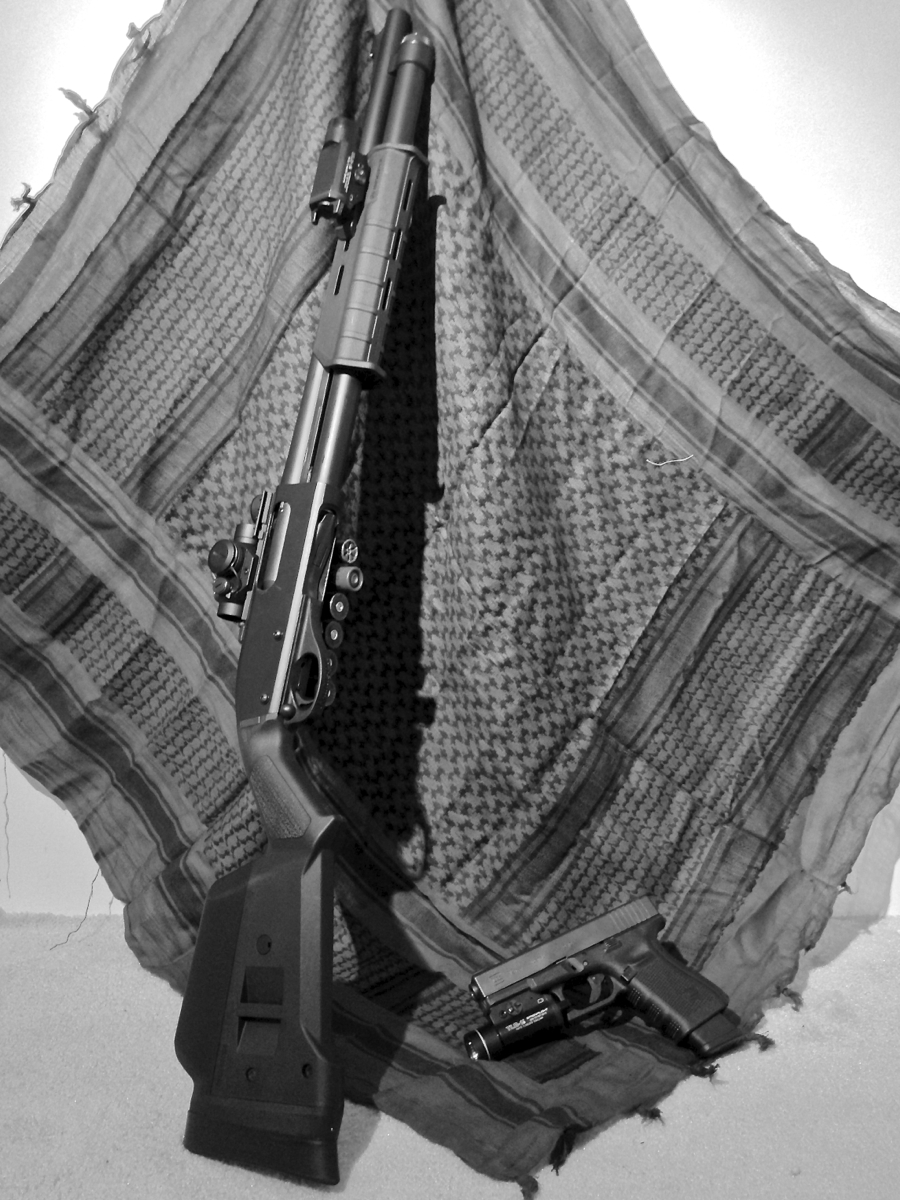

1 Comment